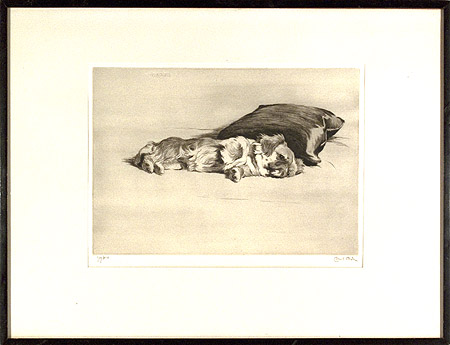
Pekingese
|
|
The history of the Pekingese is full of romance and intrigue, for in China, its country of origin, ownership was thought to have been the privilege of the Royal Family. These little dogs were kept by the eunuchs of the Palace, and its beautiful, secret corridors are said to have rung with the playful barking of the little "lion dog of Peking." Indeed, the dog held a special place because of its likeness to the lion. As Edward C. Ash, in Dogs: Their History and Development has pointed out, "The Pekingese dog represented to the Chinese mind a symbol of the great protector of the faith - the Buddha's lions, which when the necessity arose, were produced by stretching forward his hand, his fingers changing into five of these lions, which, roaring with a voice that shook the heavens, brought enemies into subjection." The earliest of the Pekingese can be traced in China to the eighth century and they are depicted throughout the art on China, on tapestries, vases and screens. It was in the nineteenth century that the first Pekingese were imported to England. The Empress Dowager Tzu Hsi had been very fond of the breed, having taken great care in her breeding program to achieve desirable colors and markings. Unfortunately, when the English invaded the palace in 1860, most of the dogs were found lying dead, for the Chinese did not want them to fall into the hands of the infidels. Five living dogs were found, however, evidently protecting the body of the Emperor's aunt. Admiral Lord John Hay, who was captain of the HMS Oding procured a pair. Another pair, later to be named Guh and Meh, were presented to the Duchess of Richmond and Gordon (who founded the well-known Goodwood strain of Pekingese) by a relative of her husband who was in Peking at the time. The last of this group of five was presented to Queen Victoria by General Dunne: the charming little Lootie, a small parti-colored specimen. During the 1860's several more Pekingese were imported from China and the breed quickly established itself. The Pekingese Club was founded in 1902 and the Peking Palace Dog Association in 1908. Indeed, the breed became very popular and perhaps because of its mysterious origins and exotic appearance, it became a favorite for artists to depict. Lilian Cheviot (exh. 1894-1902), Maud Earl (1864-1943), Frances Fairman (ca. 1836-1923) J.W. Keyl(1823-1871), and Arthur Wardle (1864-1949) each depicted the Pekingese. |
Home | About
the WS Gallery | Current
Exhibition | New
Additions | Search Our Inventory
| Commissioning Paintings | 19th
& 20th Century Oils | Contemporary
Artists | Works
on Paper & Collectibles | Books
| Christine Merrill
| Guest book | Email
Us
All images, designs and information on this site
are fully copyrighted © 1999
and may not be reproduced of used in any form or any manner, or displayed in
any way
on any website without the express written consent of The William Secord Gallery,
Inc.
William Secord Gallery, Inc.
29 West 15th Street 4th floor
New York, NY 10011
Between Fifth and Six Avenues
www.dogpainting.com
wsecord@dogpainting.com
Tel. 212-249-0075
212-249-0896
By appointment
